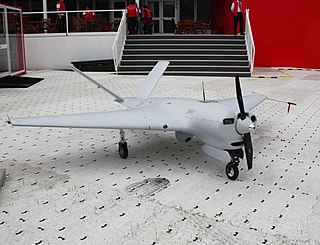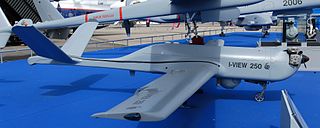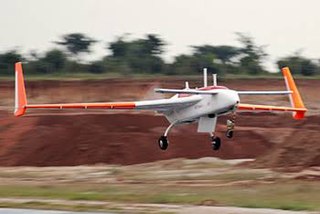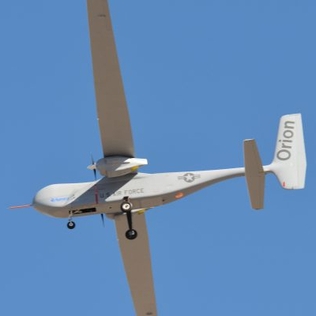
The Alliant RQ-6 Outrider unmanned aerial vehicle (UAV) was designed to provide near-real-time reconnaissance, surveillance, and target acquisition information to United States Marine Corps air/ground task forces, United States Army brigades, and deployed United States Navy units that was small enough for an entire system to be contained on two Humvees and trailer and transported on a single C-130 Hercules cargo aircraft.

The Sikorsky Cypher and Cypher II are types of unmanned aerial vehicles developed by Sikorsky Aircraft. They are vertical takeoff and landing aircraft which use two opposing rotors enclosed in a circular shroud for propulsion.

The Bell Helicopter Eagle Eye, Model 918, was an American tiltrotor unmanned aerial vehicle that was offered as one of the competitors in the United States Navy's VT-UAV program.
The EADS 3 Sigma Nearchos is a medium distance reconnaissance unmanned aerial vehicle (UAV) introduced in 1996, one of several UAVs developed by the Greek 3 Sigma aerospace company, in collaboration with Greek universities.
The Yarará project is the first unmanned aerial vehicle (UAV) programme in South America to be produced in series and for export. The system is developed by Nostromo Defensa for surveillance, border patrol and reconnaissance. It was unveiled at the Argentine Air Force Air Show on 10 August 2006. The manufacturer says it has been produced in small series for export to an unidentified government customer in the United States.

The Elbit Systems Skylark I and Skylark II are miniature UAVs developed by Elbit Systems. Initial models of the Skylark entered service in 2008.

NITI is a very light-weight, stealthy remote-controlled Bulgarian unmanned aerial vehicle (UAV). It has been designed and constructed in 2006 by Armstechno Ltd. It mounts a color surveillance camera, a thermal vision camera, and has an option for adding chemical and radioactive contamination dosimeters. Its main tasks are air surveillance of contaminated areas, regions with possible terrorist group activity, artillery correction or observation of natural disaster-stricken areas. NITI has a maximum fuel capacity of 38 L. It also has a programmable autopilot system and GPS system.
The S-TEC Sentry is a reconnaissance unmanned aerial vehicle (UAV), developed in the United States in the 1980s. Built by S-TEC systems of Texas, it is a battlefield mini-UAV in roughly the same class as the BAI Dragon drone. In fact, the Sentry looks something like an Exdrone with a twin-boom raised tail. It is built of carbon composition and Kevlar, and powered by a 19.5 kW (26 hp) piston engine in a tractor configuration.

The DRS Sentry HP is a reconnaissance UAV that was developed in the United States in the late 1980s by S-TEC. The program was acquired by Meggitt in 2000 and subsequently by DRS in 2002. Although the aircraft shares the name "Sentry" with a previous S-TEC design, the Sentry HP is a completely different machine, with a broad wing and a V tail. The Sentry HP is larger, with greater payload capacity and an underwing stores capability. It is powered by a variant of the same engine as the Sentry. It can be ordered with an option for fixed landing gear to permit conventional takeoff and recovery.

The IAI I-View is a small reconnaissance unmanned aerial vehicle developed in Israel in the early 21st century. Like other UAVs produced by IAI, it has fixed landing gear and an 18.6 kW (25 hp) piston engine. The Eye-View is also being promoted in civilian markets for forest fire warning, and in this form is appropriately known as the FireBird.
The CAC Fox is a small UAV developed in France for use as a reconnaissance aircraft and for electronic warfare. About a thousand have been sold in a number of variants, with generally similar appearance and specifications.

The DRDO Rustom is a family of medium-altitude long-endurance (MALE) unmanned air vehicle (UAV) being developed by the Defence Research and Development Organisation (DRDO) for the three services, Indian Army, Indian Navy and the Indian Air Force, of the Indian Armed Forces. Rustom is derived from the NAL's LCRA developed by a team under the leadership of late Professor Rustom Damania in the 1980s. The UAV will have structural changes and a new engine.
Kapothaka was a technology demonstrator mini-UAV for reconnaissance. The Kapothaka which means “dove” is believed to be a predecessor of Nishant UAV system.
The Imperial Eagle is an Indian light-weight mini-unmanned aerial vehicle (UAV) developed by the Aeronautical Development Establishment, National Aerospace Laboratories and supported by private vendors. Its primary users will be the National Security Guard and the military services.

TAI Gözcü is a radio-controlled short-range tactical drone. Designed, developed and built by Turkish Aerospace Industries (TAI), the unmanned aerial vehicle (UAV) is in use by the Turkish Armed Forces for intelligence, surveillance, target acquisition and reconnaissance purposes. Gözcü is the Turkish word for observer.

The HESA Hamaseh is an Iranian tactical and reconnaissance unmanned aerial vehicle (UAV) with high flight endurance built by Iran Aircraft Manufacturing Industrial Company (HESA). The Hamaseh was unveiled in 2013 and entered service in 2016.

The Orion is a Medium-altitude long-endurance unmanned aerial vehicle (UAV) developed by Aurora Flight Sciences.

The Wing Loong-10 is a series of unmanned aerial vehicles of the High-Altitude Long Endurance (HALE) type, featuring some stealth characteristics. As of 2017, it is being developed by the Chengdu Aircraft Industry Group for reconnaissance and precision strike missions.
The ATLAS C4EYE is a tactical reconnaissance UAV produced by C-Astral Aerospace Ltd from Ajdovščina in Slovenia. The ATLAS is a NATO class 1 mini-tactical UAV under 2.9 kg MTOW designed for ISR or ISTAR missions for army reconnaissance and Special Forces relying on low signature detection. It carries a payload consisting of a gyro-stabilized micro-gimbal with EO/IR sensors and laser illuminator. The ATLAS 4EYE is hand-launched, water-resistant and carries up-to-date avionics, data-link and guidance solutions.

The Vanilla UAV is a long-endurance, low-cost unmanned aerial vehicle (UAV) produced by American manufacturer Vanilla Unmanned. It has flown unrefueled over 8 days.













